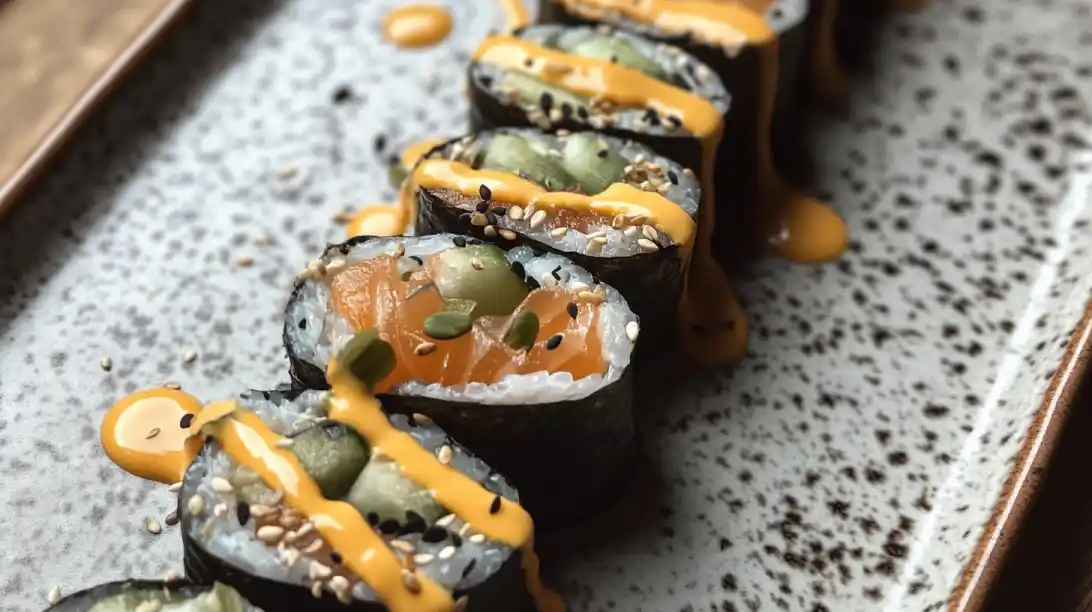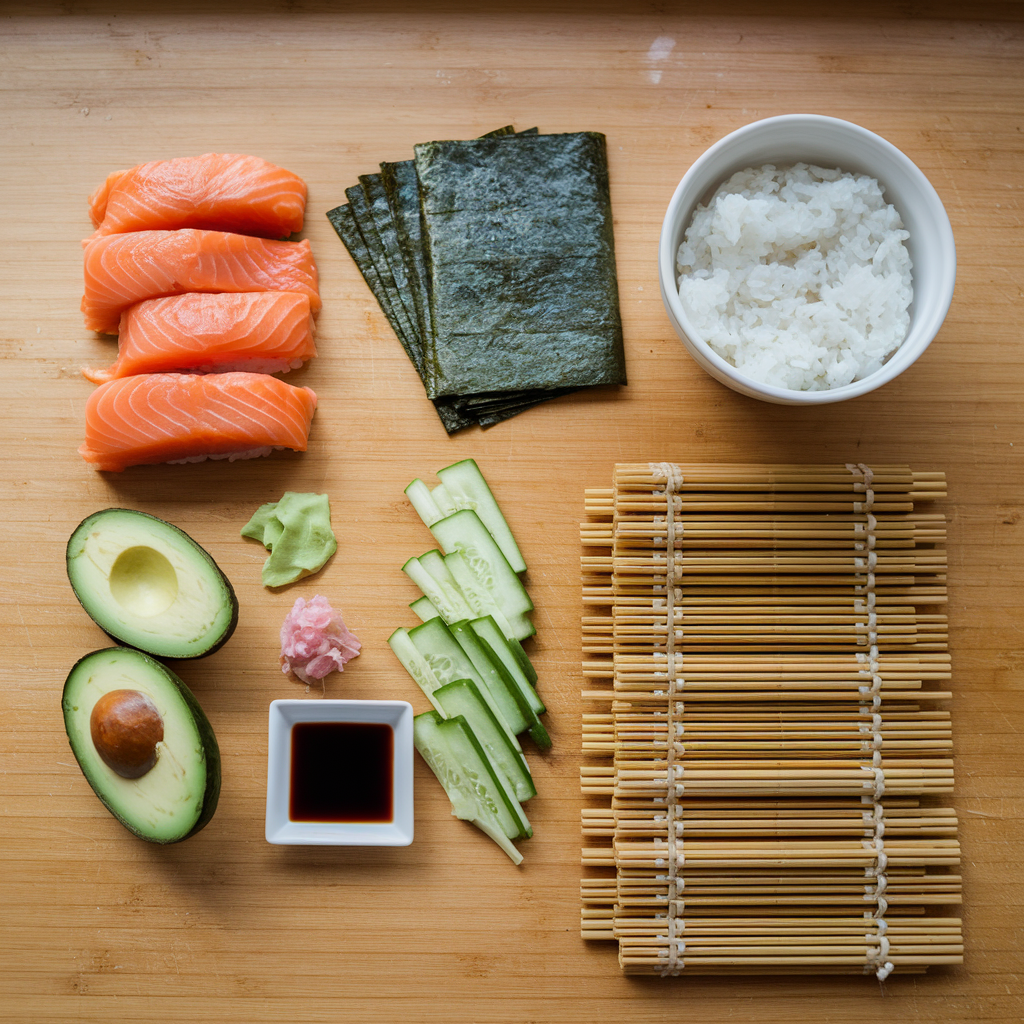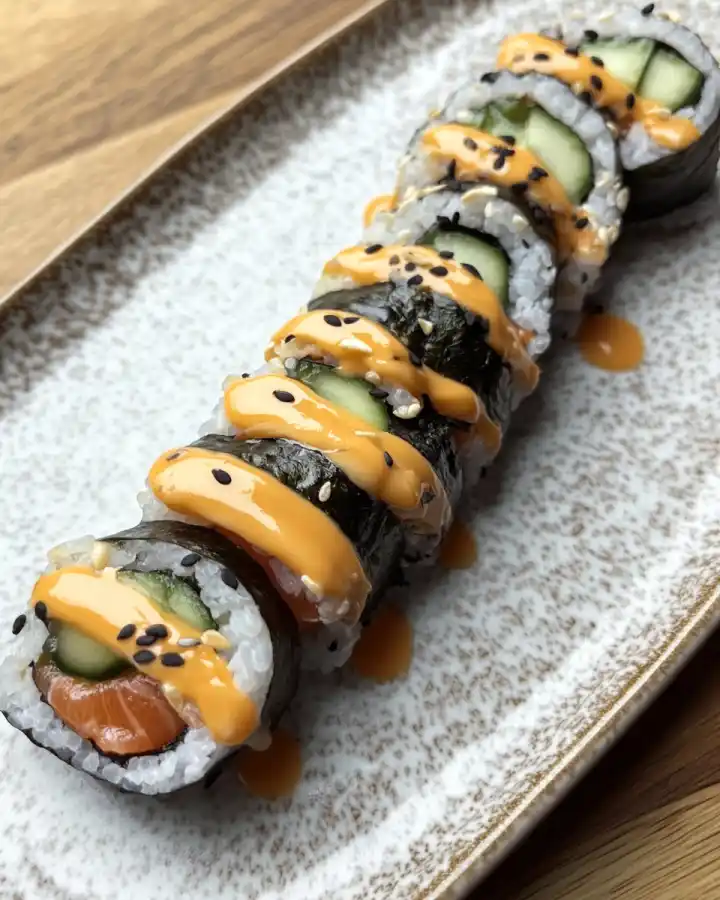The Best Fluffy Pancakes recipe you will fall in love with. Full of tips and tricks to help you make the best pancakes.

Table of Contents
Get ready to roll like a pro! 🍣
The Origins of Salmon Rolls: A Sushi Classic
Did you know that salmon sushi wasn’t always part of traditional Japanese cuisine? It wasn’t until Norwegian exporters introduced high-quality raw salmon to Japan in the 1980s that salmon rolls became a sushi staple. Today, they’re one of the most beloved sushi varieties worldwide!

Looking for more seafood inspiration? Check out this Seafood Boil in a Bag recipe for another ocean-fresh feast!
Essential Ingredients for Perfect Salmon Rolls
To make authentic, restaurant-quality salmon rolls, you’ll need:
1. Sushi Rice (Shari)
- Short-grain sushi rice
- Rice vinegar, sugar, and salt for seasoning
2. Fresh Salmon
- Sashimi-grade salmon (essential for raw sushi)
- Alternatively, cooked salmon for a smoky flavor
3. Sushi Nori (Seaweed Sheets)
- High-quality nori ensures a crisp wrap
4. Fillings & Extras
- Avocado for a creamy texture
- Cucumber for a refreshing crunch
- Cream cheese for a rich, indulgent taste
5. Spicy Mayo Sauce
- Mayonnaise + Sriracha + Sesame Oil

For more sushi ingredient insights, check out this guide on Crunchy Roll Sushi!
Step-by-Step Recipe: How to Make Salmon Rolls
🕒 Prep Time: 20 minutes
🔥 Cook Time: 10 minutes
🍣 Yield: 6-8 sushi rolls
1. Cook & Season the Sushi Rice
- Rinse 1 cup of sushi rice under cold water until clear.
- Cook in a rice cooker (or stovetop, 1:1.25 rice-to-water ratio).
- Once cooked, mix with 2 tbsp rice vinegar, 1 tbsp sugar, and ½ tsp salt. Let cool.
2. Prepare the Salmon
- If using raw salmon, slice into thin, even strips.
- If cooking salmon:
- Brush fillets with olive oil, bake at 375°F for 12-15 minutes, and flake into pieces.
3. Chop & Prep Fillings
- Julienne the cucumber for thin strips.
- Slice the avocado into even pieces.
- If using cream cheese, cut into long, thin slices.
4. Assemble the Rolls
- Lay a nori sheet (shiny side down) on a sushi mat.
- Spread a thin layer of sushi rice, leaving 1 inch at the top.
- Arrange salmon, avocado, cucumber, and cream cheese horizontally.
- Roll tightly, using the sushi mat to press firmly.

5. Slice & Serve
- Using a sharp knife, cut into 8 equal pieces.
- Drizzle with spicy mayo and sprinkle with sesame seeds.

Looking for crispy sushi ideas? Check out What’s in the Crunchy Roll? for a textured sushi twist!
Creative Salmon Roll Variations
Love to mix things up? Try these delicious variations!
1. Spicy Salmon Rolls 🌶️
- Mix chopped salmon with Sriracha & spicy mayo before rolling.
2. Philadelphia Rolls 🏙️
- Add extra cream cheese for a New York deli-inspired twist.
3. Tempura Salmon Rolls 🍤
- Lightly coat in panko breadcrumbs and fry for a crispy crunch.
4. Teriyaki Salmon Rolls 🍯
- Drizzle homemade teriyaki glaze over sliced rolls.
For more bold flavors, check out this Tarragon Culinary Guide for herb-pairing ideas!
Best Dipping Sauces for Salmon Rolls
Pair your sushi rolls with these savory dips:
✔️ Soy Sauce – Classic & salty
✔️ Ponzu Sauce – Citrusy & refreshing
✔️ Eel Sauce – Sweet & umami-rich
✔️ Wasabi & Pickled Ginger – Traditional sushi pairings
For homemade sauce inspiration, try this Garlic Parmesan Sauce—perfect for seafood!
How to Store Leftover Salmon Rolls
- Refrigeration: Store in an airtight container for up to 24 hours.
- Avoid Freezing: The rice texture changes when frozen.
- Best Served Fresh: Sushi tastes best when enjoyed the same day!
For more meal prep hacks, explore these Quick Healthy Meals!
Choosing the Best Salmon for Sushi: A Buyer’s Guide
Not all salmon is created equal when it comes to sushi-grade quality. Choosing the right salmon ensures a safe, delicious, and authentic sushi experience.
Types of Salmon for Sushi Rolls
- Sashimi-Grade Salmon – The gold standard for sushi, carefully frozen to eliminate parasites.
- Wild-Caught vs. Farmed Salmon – Wild salmon is leaner with a stronger flavor, while farmed salmon has a buttery texture.
- Smoked Salmon – A great no-cook option for added savory depth.
- Baked or Pan-Seared Salmon – Ideal for those who prefer cooked sushi rolls.
Where to Buy Sushi-Grade Salmon
- Japanese markets (like H Mart or Mitsuwa)
- Specialty seafood stores
- Online seafood suppliers offering flash-frozen options
For more seafood buying tips, check out our King Salmon Recipes guide!
The Role of Rice in Salmon Rolls: Why It Matters
Sushi rice isn’t just a filler—it’s the foundation of a great sushi roll. The right rice can make or break your salmon rolls!
What’s the Best Rice for Sushi?
✔️ Short-Grain Sushi Rice – Sticky, soft, and holds shape well.
✔️ Medium-Grain Rice – Works if sushi rice isn’t available, but slightly less sticky.
✔️ Brown Sushi Rice – A fiber-rich alternative for a healthier roll.
How to Perfectly Season Sushi Rice
- Rinse the rice to remove excess starch.
- Use a 1:1.25 rice-to-water ratio for the ideal texture.
- Mix in rice vinegar, sugar, and salt while warm for the perfect balance of sweetness and tang.

Curious about other rice-based dishes? Read Best Rice for Arroz Imperial for expert recommendations!
How to Make Restaurant-Style Salmon Rolls at Home
Want your homemade salmon rolls to look and taste like they came from a high-end sushi bar? Follow these expert techniques!
Pro Tips for Rolling Perfect Sushi
🔹 Use a Bamboo Sushi Mat – Helps keep rolls tight and even.
🔹 Wet Your Hands & Knife – Prevents rice from sticking.
🔹 Leave a 1-inch Border – Ensures clean rolling and sealing.
🔹 Apply Gentle Pressure – Avoids overstuffing and breakage.
Plating & Presentation Tricks
✨ Garnish with sesame seeds, microgreens, or edible flowers for an elegant touch.
✨ Arrange in a spiral or fan shape for restaurant-style plating.
✨ Serve with decorative soy sauce designs for an Instagram-worthy dish!
For more plating inspiration, check out Seafood Boil in a Bag—a stunning dish for any occasion!
Health Benefits of Salmon Rolls: A Nutritious Choice
Eating salmon rolls isn’t just delicious—it’s also great for your health! Packed with protein, omega-3s, and essential nutrients, salmon sushi is a nutrient-dense choice.
Key Health Benefits
✔️ Rich in Omega-3 Fatty Acids – Supports heart and brain health.
✔️ High in Lean Protein – Helps muscle recovery and satiety.
✔️ Low in Processed Carbs – A better alternative to fried sushi rolls.
✔️ Packed with Antioxidants – Avocado and seaweed add anti-inflammatory benefits.
How to Make Your Salmon Rolls Even Healthier
- Use brown sushi rice for more fiber.
- Swap cream cheese for Greek yogurt or mashed avocado.
- Load up on veggies like carrots, spinach, or bell peppers.
For more healthy meal options, check out Quick Healthy Meals for Busy Lifestyles!
Pairing Drinks with Salmon Rolls: Best Beverages to Complement Sushi
Pairing your salmon rolls with the right drink enhances the flavors and textures of the sushi experience.
Best Alcoholic Pairings
🍶 Sake – A classic choice that enhances umami flavors.
🍺 Japanese Beer (Sapporo, Asahi, Kirin) – Light and crisp, cuts through the richness of salmon.
🍷 Dry White Wine (Sauvignon Blanc, Riesling) – Refreshing acidity that balances sushi’s creaminess.
Non-Alcoholic Pairings
🍵 Green Tea – Cleanses the palate and enhances sushi’s delicate taste.
🥤 Sparkling Water with Lemon – Light and refreshing without overpowering flavors.
🥭 Mango Iced Tea – Adds a fruity contrast to the savory salmon.
For a unique drink pairing, check out Mango Margarita—a sweet and tangy complement to sushi!
FAQs About Salmon Rolls
Can I use smoked salmon instead of raw salmon?
Yes! Smoked salmon adds a rich, salty flavor—no cooking required.
What’s the best knife for slicing sushi?
A sharp, non-serrated knife dipped in water prevents sticking.
How do I keep sushi rolls from falling apart?
Press firmly while rolling and use just enough rice—too much makes rolling difficult.
Can I make salmon rolls without a bamboo mat?
Yes! Use plastic wrap or parchment paper to roll by hand.
What other fish can I use for sushi rolls?
Try tuna, yellowtail, shrimp, or crab for different flavors!
Conclusion: Time to Roll! 🍣
Making homemade salmon rolls is easier than you think—and the results are delicious! Whether you love classic sushi, spicy rolls, or creamy textures, there’s a salmon roll variation for everyone.
🔥 Now it’s your turn! What’s your favorite way to enjoy salmon rolls? Let us know in the comments!
For more Japanese-inspired recipes, check out our Ramen Bowl Guide! 🍜






